|
Dispholidus typus (Boomslang)
iNambezelu, iNyushu [Xhosa]; inDlondlo [Ndebele]; Logwere
[Tswana]; Legwere [North Sotho]; Khangala [Venda]; Muroxwe[Venda]; Coracunda
[Shona]
Life >
Eukaryotes
>
Opisthokonta >
Metazoa
(animals) > Bilateria > Deuterostomia >
Chordata >
Craniata > Vertebrata (vertebrates) > Gnathostomata (jawed vertebrates) >
Teleostomi (teleost fish) > Osteichthyes (bony fish) > Class:
Sarcopterygii (lobe-finned fish) > Stegocephalia (terrestrial vertebrates) >
Tetrapoda
(four-legged vertebrates) > Reptiliomorpha > Amniota >
Reptilia (reptiles) >
Romeriida > Diapsida > Lepidosauromorpha > Lepidosauria >
Squamata > Serpentes
(snakes) > Family: Colubridae > Subfamily:
Colubrinae
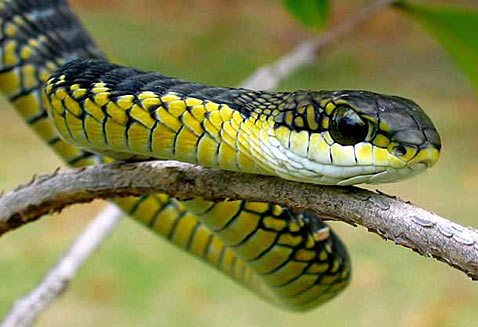
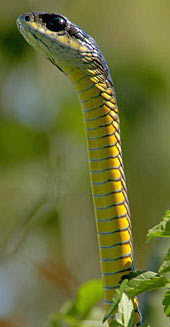 |
|
Left: Boomslang, Western Cape [J.C. Els ©, from
SARCA
Virtual Museum]; Right: Boomslang, Western Cape [photo T. Phelps ©] |
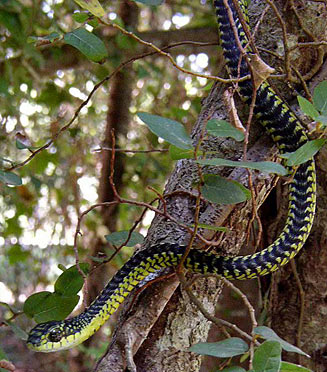 |
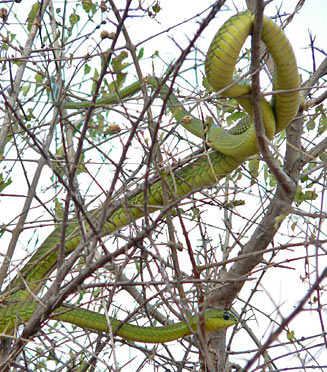 |
|
Boomslang, Western Cape. [photo A. Rebelo
© from
SARCA
Virtual Museum |
Boomslang in small shrub, Kruger National Park. [photo Francois Dreyer
©] |
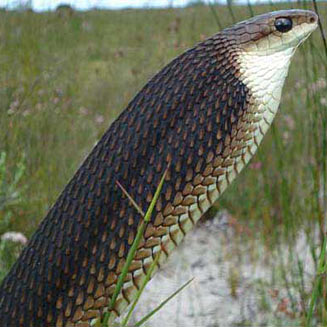 |
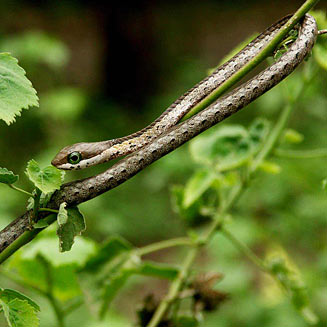 |
|
Boomslang, Western Cape, with neck inflated in
threat posture. [photo C. Dorse & S. van Rooyen
©, from
SARCA
Virtual Museum] |
Juvenile Boomslang, Mpumalanga [photo CK Willis
©, from
SARCA
Virtual Museum] |
|
|
|
|
Identification
Can be identified by its large eye (the largest of any
snake in Africa), a small head, its ability
to inflate its neck when threatened, its keeled (rough) scales, and a two tone colour
body (normally), males are often black and yellow while females are brown or
olive coloured; there are even some specimens that are red. The Boomslang has
the reputation of having more colour variations than any other snake in South
Africa. This snake has an average length of 1.3 meters but may reach 2 meters.
Distribution and habitat
The Boomslang has a wide distribution: within southern
Africa it is present in
almost all provinces except the Northern Cape, it is however absent from the
northern part of the Western Cape and part of the Free State. It is also found
in Swaziland, southern Mozambique, most of Botswana and northern Namibia. It has
a wide habitat range including lowland forest, savanna, grassland, fynbos and
Karoo scrub. It is very rarely seen on the ground, being usually found in trees
or small shrubs.
Food
Consists primarily of chameleons but also consists of
lizards, birds, birds eggs and
frogs.
Predators, parasites and disease
This snake is preyed on by
birds of prey and other snakes
(including its own species).
Reproduction
Oviparous (egg laying) and generally lays
between 8 and 14 eggs in late spring or early summer, The Boomslang mates in a
tree unlike most other snakes which mate on the ground, It is able to lay its
eggs either in disused birds nests or on the ground near a tree.
Longevity
Average life span is eight years.
Medical importance
This snake has a lethal haemotoxic venom which although
dangerous is very slow acting (it may take 24 hours for the symptoms to become
apparent). It requires a unique antivenom which is luckily available from
all major provincial capital hospitals in its range. However it is rarely
required because the Boomslang is a non-aggressive snake and is seldom seen.
Most of its victims are snake handlers who have antagonized it.
Links
References
-
Broadley, D.G. 1983. FitzSimons' Snakes of Southern
Africa. Delta Books, Johannesburg.
-
Marais, J. 2004. A Complete Guide to Snakes of
Southern Africa. Struik Publishing, Cape Town.
|
